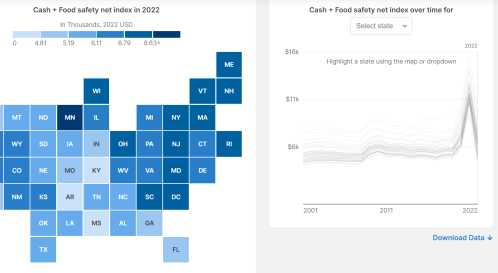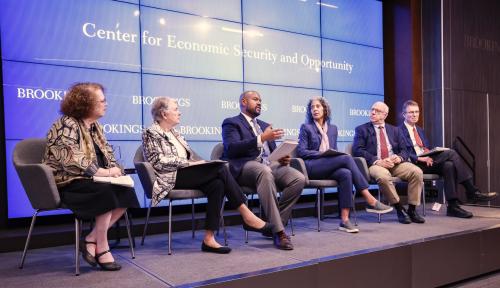This is a summary of an event held on June 3, 2025. You can watch the full video of the event here.
On June 3, 2025, the Hutchins Center on Fiscal and Monetary Policy and the Center for Economic Security and Opportunity hosted a panel discussion reflecting on the impact of the Earned Income Tax Credit (EITC) as the program reaches its 50th anniversary. Moderated by David Wessel, director of the Hutchins Center, the panel included Jacob Bastian of Rutgers University, Jim Sullivan of the University of Notre Dame, Henrik Kleven of Princeton University, and Hilary Hoynes of UC Berkeley.
Jacob Bastian opened the discussion with an overview of the five-decade history that led to the EITC’s current reach: providing over $70 billion dollars to roughly 30 million low-income, working families each year. He also highlighted findings attributing about one-third of the substantial increase in single mothers’ labor force participation during the 1990s to the EITC. Overall, he concluded that “the EITC at 50 helps … tens of millions of low-income families and has done a lot of good.”
Henrik Kleven presented a different viewpoint on the labor supply effects of the EITC. Klevin’s own research led him to conclude that EITC reforms have likely had minimal impact on single mothers’ employment. He emphasized, however, that he still considers the program a success due to its poverty alleviation effects. Klevin even argued that smaller employment responses could be good news, as distorting labor supply through the EITC may be undesirable.
Calling the EITC “one of the most successful anti-poverty programs,” Jim Sullivan cited estimates that the program lifts 6 million individuals, including 3 million children, out of poverty. Moreover, he noted that a large share of EITC benefits go to children in particularly vulnerable circumstances, such as children being raised by single mothers with low levels of education. Nonetheless, the credit is not available to families without earnings. Sullivan pointed to several groups that currently receive less assistance or none at all: families in deep poverty, workers who aren’t raising children, and roughly one-fifth of eligible individuals who don’t claim the credit.
Hilary Hoynes reflected on a more recent wave of EITC research examining the impact of the credit’s anti-poverty boost on families’ lives. This work has found that EITC access during childhood has long-run benefits that extend into adulthood, including higher educational attainment and higher lifetime earnings. In this sense, Hoynes argued, the EITC serves as an investment in children: “The more you spend when children are young, the less you spend as a society when children are older.”
The Brookings Institution is committed to quality, independence, and impact.
We are supported by a diverse array of funders. In line with our values and policies, each Brookings publication represents the sole views of its author(s).







Commentary
The EITC at 50: Key takeaways from a recent Brookings panel
June 10, 2025